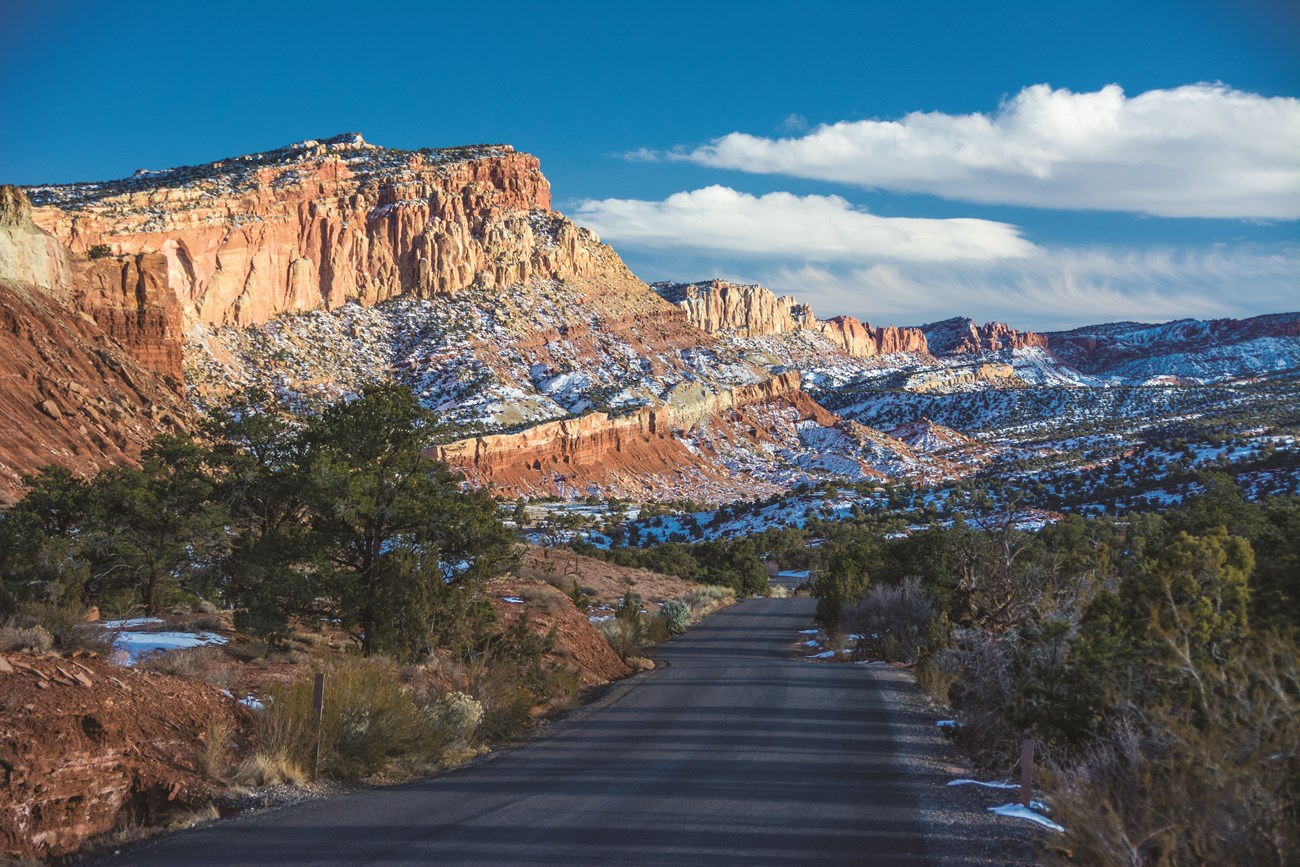
NPS/Chris Roundtree The Scenic Drive is a 7.9 mile (12.7 km) paved road, suitable for passenger vehicles. Allot about an hour and half roundtrip to drive the Scenic Drive and the two dirt spur roads, Grand Wash and Capitol Gorge. These dirt spur roads enter canyons and lead to trailheads, and are usually suitable for passenger cars and RVs up to 27 feet in length. The Scenic Drive, Grand Wash, and Capitol Gorge roads can be closed due to snow, ice, mud, and flash floods. Check at the visitor center, or call 435-425-3791, for possible road closures. Press #1 for information, and then #4 for current road conditions. For weather conditions press #3. You are responsible for your own safety. 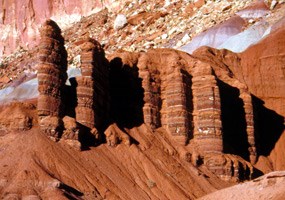
NPS STOP 1 Most rock at Capitol Reef is sedimentary, formed in layers from loose materials, like mud and sand. Geologists classify the rock layers into various formations. Many formations also have different parts, or members. These layers record the landscapes and lifeforms of a younger planet Earth. Thin beds of reddish-brown shale were formed from silt and clay that came to rest in the quiet waters of lagoons, mud flats, and coastal flood plains. This 225 million year old rock is the Moenkopi Formation. The Moenkopi, more than 950 feet (290 m) thick in places, was laid down in a moist, tropical climate. The banded gray and burgundy layers above the Moenkopi contain volcanic ash. The Chinle Formation, a complex, 700 foot (213 m) thick formation rich in petrified wood ascends to the base of a sheer cliff wall. 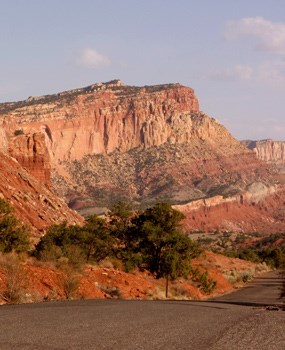
NPS STOP 2 The rugged western escarpment of Capitol Reef tells the essentials of a complex story. Rock bands of differing thickness, colors, and textures lay one upon another like layers of a cake. The rocks of Capitol Reef were once sediments (silt, sand, clay, and gravel) laid down in many different environments during the past. Younger rocks lie on top of older rocks. Notice the tilting of the rock layers? Intense crustal pressure reactivated a fault buried deep beneath the sedimentary rock layers of the Colorado Plateau. In response, the overlying sedimentary rock layers folded or bent into a one-sided slope called a monocline. This 100 mile (161 km) long (but relatively narrow) feature was uplifted approximately 6,800 feet (2,000 m) higher on the west side. It is named the Waterpocket Fold because of the numerous small potholes, tanks, or "pockets" that hold rainwater and snowmelt. The Waterpocket Fold has been beset by erosion since its creation. Erosion includes weathering, the transportation of material, chemical wearing, and the effects of gravity. Frost, plant roots, internal water seepage, and flash floods have all played a part in the drama of Capitol Reef. Deposition, uplift, and erosion are the major geologic processes which created this landscape. 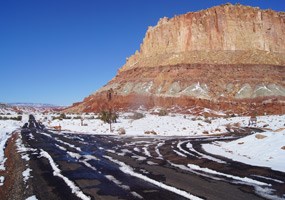
NPS STOP 3 The twisting Grand Wash spur road takes you into a landscape dramatically different from the dark red hills along the base of Capitol Reef. Grand Wash is a narrow, steep-walled canyon subject to dangerous flash floods that often arrive with little warning. Avoid canyons and washes when storms threaten. Beyond a short drive, foot trails lead into the narrowest part of the canyon and up to Cassidy Arch on the canyon's north wall. The arch was named for turn of the century outlaw Butch Cassidy, who is thought to have hidden occasionally in Grand Wash. Gated entrance holes can be seen at the mouth of Grand Wash at the base of a layer of yellowish-gray rock. These mark the abandoned Oyler Uranium Mine, opened in 1901 when uranium was used in some patent medicines. 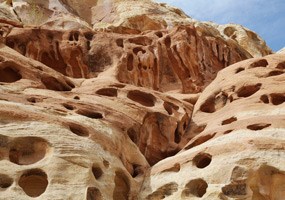
NPS STOP 4 The massive, sheer cliffs of Wingate Sandstone have sweeping lines that intercept one another at varying angles in the rock. Large scale crossbedding indicates windswept drifted dunes of an ancient desert. Sediment becomes rock when it is buried and compacted by overlying loads of other sediment. Individual sand or clay particles are cemented together by minerals in seeping ground water. Eventually, the cement of the rock is dissolved by weak acids in rainwater. Small cracks are widened by frost and plant roots. The rock washes away in chunks and particles. Weathering is part of the larger process of erosion. Shallow holes in the cliff are excavated as water erosion removes more weakly cemented sand grains, leaving solution pockets and natural bridges. 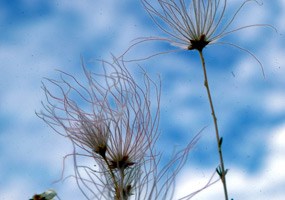
NPS STOP 5 Vegetation is more abundant in Grand Wash. Although relatively bare stone, or slickrock, dominates the landscape here, plants also are plainly visible. Channels and washes, although usually dry, carry water often enough to support a step shrub ecosystem. Plants like Apache-plume are rarely found far from washes. Other species, like rabbit brush, tolerate drier environments. Flash floods can roar down canyons, carrying debris that crushes and smothers vegetation. Plant life survival requires fulfilling the need for adequate water and protection from floods. 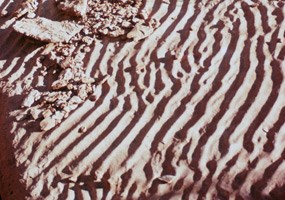
NPS STOP 6 The road now winds through an older, deeper part of the Moenkopi Formation. Uniform layers of sandstone can be seen among the red shale beds, often forming small ledges. These thinner beds of sandstone were deposited by water. The surfaces of many slabs are covered with ripple marks or mud cracks that formed when pools of water dried under a hot sun. Aqueous trackways, or swim smears, record the passage of extinct primitive reptiles making their way across shallow pools. This formation was laid down by the gently moving waters of coastal tidal flats. 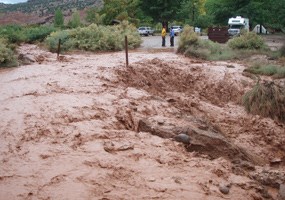
NPS STOP 7 Slickrock Divide separates two large drainages. To either side of this hill, streambeds channel rain runoff and debris into Grand Wash to the north, and Capitol Gorge to the south. When rain does come to Capitol Reef, it often descends in torrents. Large expanses of bare rock and thin patches of soil can do little to absorb and hold it. Poets sometimes speak of water as "carving the face of the land". However, rushing water shapes this landscape by carrying away material already loosened by weathering. Gravity draws loosened debris to washes where it is picked up by moving water. This slow process of gravitational "creep" is accelerated by the deluges of desert thunderstorms that wash down slopes and flush loose debris into channels soon filled with a tumbling, red torrent. Imagine all the torrents of a plateau converging upon a single gorge and you will realize how floods develop in a "flash". 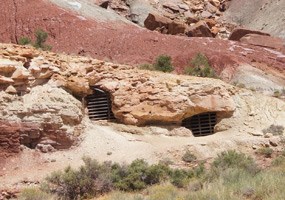
NPS STOP 8 The yellowish-gray Shinarump is a very distinct member found intermittently at the base of the Chinle Formation. Its discontinuous nature hints at the way it was deposited. Shinarump sediments, laid down in the channels of rivers that meandered across a coastal plain 200 million years ago, are composed of sands and gravels like those in many shallow river beds today. Because rivers meander instead of blanketing an area, the Shinaump is visible only sporadically. Shinarump also contains uranium ore. The old mine tunnels at the mouth of Grand Wash penetrate the Shinarump. 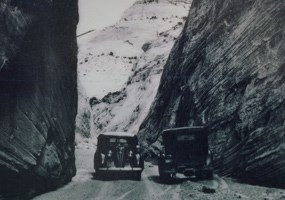
NPS STOP 9 The Capitol Gorge spur road is longer and more winding than Grand Wash. Although a through road from 1884 to 1962, the drive now ends in a few miles. These narrows twist through Wingate Sandstone, the formation that forms the sheer cliffs along the west face of Capitol Reef and the towering walls of Grand Wash. Capitol Gorge provides dramatic evidence of the forces of erosion at Capitol Reef National Park. Consider the weather before proceeding into the gorge. 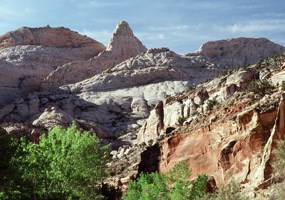
NPS STOP 10 The Navajo Formation, over 1,400 feet (427 m) thick in places, caps the upper reaches of Capitol Gorge. Its white, rounded domes, reminiscent of the nation's capitol building, inspired part of the name for Capitol Reef. Prospectors with seafaring experience viewed this monocline as a barrier to transportation, and supplied the nautical term "reef". Wingate and Navajo, both formed from ancient deserts, seem to erode differently. The Wingate tends to make sheer cliffs; the Navajo rounded domes. The Wingate lies on soft beds of Chinle Formation. Because this softer rock erodes more rapidly and undercuts the Wingate, the massive sandstone often breaks away to form sheer cliffs. By contrast, the Navajo rests on a firm foundation of a Kayenta. The Navajo is undercut less often than the Wingate and erodes away in smoother contours. The Kayenta lies above the Wingate and below the Navajo Formation. It is about 350 feet (107 m) thick and 190 million years old. 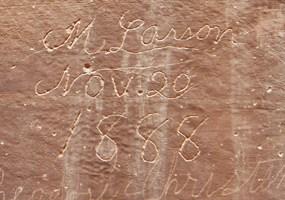
NPS/Sandy Borthwick STOP 11 Dune lines in Navajo Sandstone walls evidence ancient landscapes and sediments that became rock. Rounded domes and deep canyons demonstrate the power of erosion. The rapid sequence of rock layers along the fairly level Capitol Gorge spur road confirms the tilting and bending of the Waterpocket Fold. Geology creates the foundation for human habitation. Worn petroglyphs can be seen after a short stroll into Capitol Gorge. Prehistoric people of Fremont Culture used area rock for tools and projectile points, and for the foundations of their homes. Clay was used for pottery, construction and to make figurines. Fertile floodplains supported crops of corn, beans, and squash along the streams of Capitol Reef until about 1300 CE. Mormon pioneers took eight days in 1884 to clear the first road through the Gorge, and settlers had to remove heavy debris after every flash flood. Early travelers recorded their passage on the canyon walls at the Pioneer Register. The road was closed in 1962 when Utah Highway 24 was paved through the Fremont River corridor. |
Last updated: January 2, 2022
